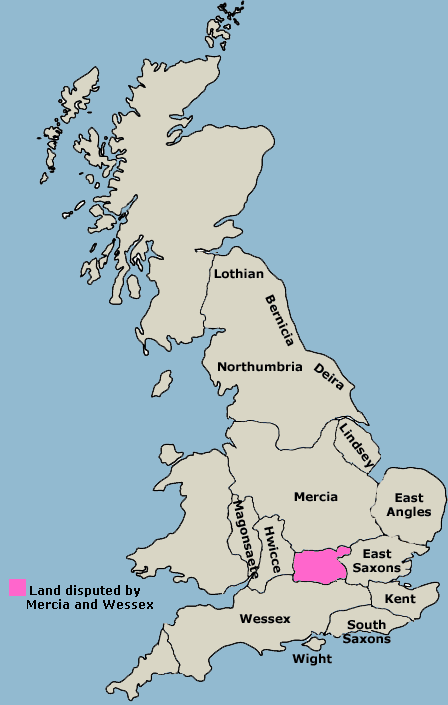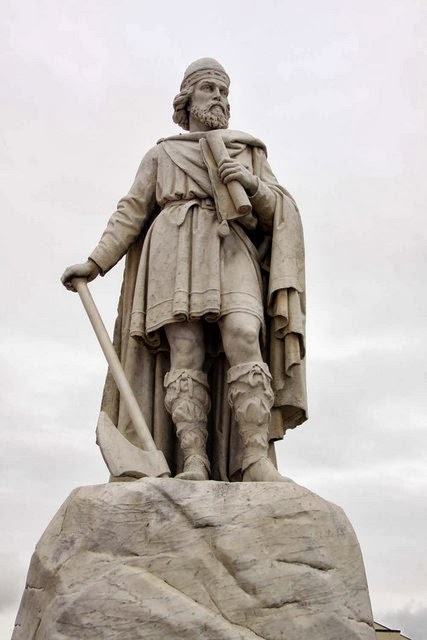 |
| Anglo-Saxon Kingdoms |
Following the decline of Roman power in Britain, political power rapidly decentralized, and several small kingdoms emerged to fill the political vacuum. These kingdoms, called the Anglo-Saxon kingdoms, competed among themselves and with Danish invaders for power from the late sixth through the ninth centuries. Eventually they melded into one large kingdom that governed most of England until the Norman Conquest of England in 1066.
Throughout the fourth and fifth centuries a number of Germanic peoples invaded England. Some came with military objectives in mind, but many others came as settlers, seeking peaceful colonization. These people came from several tribes, but the most famous were the Angels and Saxons, many of whom came as raiders and mercenaries seeking employment in Roman Britain’s undermanned military outposts. Beyond this, details of the invasion are unclear. The invaders stamped out all vestiges of Roman culture, but the complex transition to Anglo-Saxon England occurred gradually.
How many small kingdoms existed during the sixth and seventh centuries is unknown, but as larger kingdoms eliminated rivals, the number shrank. This consolidation of power has led historians to identify the movement toward a territorial state as one of the main themes in Anglo-Saxon history.
  |
As post-Roman chaos subsided, Anglo-Saxon England painstakingly settled into seven or eight major kingdoms and several smaller ones. The kingdoms centered on the Thames, Wash, and Humber, the main entry points for the migrations. Factors influencing the shapes and formation of the kingdoms also included geography, defensibility, and the degree of resistance the inhabitants offered the invaders.
Four kingdoms developed around the Thames estuary. In the southeast, Kent arose with unique artistic, legal, and agrarian traditions, influenced by Jutish and, possibly, Frankish culture. West and northwest of Kent three kingdoms associated with the Saxon invasions developed: Essex (East Saxons), Wessex (West Saxons), and Sussex (South Saxons). Settlers who entered via the Wash founded East Anglia, forming groups called the North Folk and South Folk, whose territories became Norfolk and Suffolk.
Those who entered by the Humber formed Mercia, which dominated the Midlands, and Northumbria, north of the Humber River, that grew from the unification of the smaller kingdoms of Deira and Bernicia. These kingdoms are traditionally called the Heptarchy, a misleading term that implies seven essentially equal states. In fact at times many more than seven kingdoms existed, and the seven main kingdoms were rarely political equals.
Developments in the institution of kingship were vital in the political growth of the early kingdoms. Germanic peoples had a tradition of kingship, and as Roman institutions declined, they looked to their own heritage to replace Roman customs. The practical appeal of kingship is clear.
It offered strong personal leadership and the kind of governing that led to success during the Anglo-Saxon invasion and settlement. The post-Roman political situation demanded similar leadership. Christian tradition held up biblical kings as examples of good leadership, and as Anglo-Saxons converted, this bolstered Germanic notions about the institution.
By the mid-seventh century, royal houses had emerged, and a claim of royal lineage became necessary for a king to rule unchallenged. The bloodline was important, but other Western notions about kingship had not yet taken hold. The successor had to be both from the right line and the fittest to rule.
How closely related to the previous king he had to be was debatable, and the right of the eldest son to succeed, the right to pass the succession through the female, the rights of a minor or female to inherit, or the right of a king to choose his successor were not guaranteed. In case of a disputed succession, kingdoms were divided or shared, which was risky but preferable to feud or civil war.
Toward the end of the seventh century a group of leaders emerged known as Bretwaldas. The first Bretwaldas were kings whose actions gained them fame and reputation and who had the political and military power to reach beyond their borders and collect tribute from neighbors. According to Bede, by around 600 one king customarily received this title from his royal colleagues, giving him preeminence within the group.
The position shifted from one dynasty to the next, with changing political and military successes. At first the title was largely honorary, and it is unclear whether other kings listened to the Bretwalda’s demands, but as time passed the authority of the Bretwalda grew.
 |
| Anglo-Saxon war |
In the late sixth and early seventh centuries the eastern kingdoms had the political edge, but strong rivalries existed and power shifted frequently. England’s population and prosperity grew in the seventh century, and much of England converted to Christianity. A common language, common social institutions, and, eventually, a common religion counterbalanced the political and military turbulence but did not stop it.
As the seventh century progressed more powerful kingdoms absorbed smaller kingdoms, and by the end of the century Northumbria, Mercia, and Wessex dominated the island. Northumbria dominated affairs in the seventh century; Mercia led the way in the eighth century; and Wessex emerged to dominate the events of the ninth century.
After King Oswy’s (642–670) defeat of Mercia in 654, Northumbria exercised lordship over the other kingdoms. Although unable to control Mercia after about 658, Northumbria nevertheless remained preeminent through its great moral authority. For example, Northumbrian support ensured the Synod of Whitby’s (663) success in promoting Roman Christian traditions over the Celtic Church throughout England. However internal dissent and external defeats steadily drained Northumbrian political and military power. Unrest, violence, and political coups throughout the eighth century doomed Northumbrian culture, culminating with the Viking sack of Lindisfarne in 793.
   |
Mercia began its rise under King Penda (628–654), and its political domination culminated under kings Ethelbald (716–757) and Offa (757–796). Many factors contributed to Mercia’s success. It held prosperous agricultural territory in the Trent Valley. The people in the east Midlands, the Middle Angles of the Fens, Lindsey, and around the Wash accepted the dynasty, as did settlers in the Severn Valley and along the borders of modern Chester, Shropshire, Herefordshire, and Gloucestershire.
London and East Anglia fell to Mercia as well. After the death of King Ine in 725, no effective resistance to Mercia remained in Wessex. Eventually it subdued Kent and threatened Canterbury. This success led Ethelbald to claim he was king of all Britain. The actions of Mercian rulers bolstered the concept of kingship.
Offa summoned papal legates, held church councils, created a new archbishopric in Lichfield, and asked the church to anoint his son Ecgfrith, all of which shows a practical desire to cooperate and benefit from relations with the church, but it also did much to strengthen his position and the theory of monarchy throughout the land.
Mercia retained power in the Midlands throughout the reigns of Cenwulf (796–821) and Ceowulf (821–823), but their popularity faded in the south and southeast following the harsh tactics they used in building a defensive system within England. Kent and East Anglia resented Mercian overlordship and led the way in uprisings in the early ninth century. The primary beneficiary of these uprisings was the kingdom of Wessex.
The rise of Wessex began with King Egbert (802–839), who defeated the Mercians in 825, winning control of Kent, Sussex, and Essex, and continued with the arrival of the Vikings. The Vikings had been making raids on England since the 780s, but in the mid-ninth century their attacks changed from raids to campaigns of conquest. In the 850s they stayed between campaign seasons, and by 865 thousands of Danes undertook a conquest that ended with their control over nearly all of England except Wessex.
Alfred the Great
 |
| Alfred the Great |
Alfred the Great (r. 871–899) came to power just after the Danish onslaught started. He was a talented king, warrior, able administrator, patron of the arts, and a good political leader, but it was a desperate moment in Anglo-Saxon history. Danes controlled the most fertile parts of north and east England.
The south held out, but it seemed only a matter of time until it too fell. To buy time while he mustered his army Alfred made a truce with the Danes in 872. He then reformed his army, fortified towns, and built a navy to meet the Viking threat.
To control his kingdom Alfred depended upon his royal court, made up of bishops, earls, king’s reeves, and some important thanes. Councils, called Witenagemots, or Witans, discussed issues such as raising military forces, building fortresses, and finances.
The king made the decisions, but he relied on the Witan for advice, support, and help making decisions known. Ealdormen, noblemen of great status who managed the shires or districts of Wessex for the king, played especially important roles.
In 876, the Danish leader, Guthrum, renewed the attack on Wessex, and by winter 878 Alfred retreated to the Isle of Athelney. In the spring he took the fight back to the Danes, defeating Guthrum and forcing him to promise to cease his attacks on Wessex and convert to Christianity. Following this, Alfred repeatedly beat back Danish attacks and gradually regained lost territory.
Around 886, Alfred and Guthrum created a boundary running northwest, along an old Roman road known as Watling Street, from London to Chester that became the Anglo-Saxon–Danish border. The cultural influences of the Danish side, the Danelaw, affected England for centuries.
The boundary also freed a large section of Mercia from Danish control, and Alfred installed a new ealdorman to control the area and married his daughter to him, uniting the kingdoms and setting the groundwork for a united England. Clashes with Danes continued, but the most severe crises had passed by Alfred’s death in 899. Under his heirs, resistance to Vikings and pagan forces came to be associated with the royal house of Wessex.
From 899 to 1016 Alfred’s descendants held the throne. They continued developing royal institutions and expanded their power base. In the late 10th century new Viking attacks coupled with internal divisions among noblemen led to the overthrow of Ethelred “the Unready” (978–1016). The Witan installed a Dane as king of England. Canute (1016–35) successfully managed Denmark, Norway, and Anglo-Saxon England and became a powerful political figure in Europe.
While Canute ruled with a Scandinavian touch, creating nobles called “earls,” most Anglo-Saxon governing institutions functioned unchanged. He brought together Anglo-Saxon and Danish nobles and won the loyalty of the Witan. When Canute died his sons ruled briefly, but each died without heir, and the Witan selected Edward, the son of Ethelred, to be king.
Edward the Confessor (1042–66) was more Norman than Anglo-Saxon, because he lived from ages 12 to 36 in Normandy. He installed Norman nobles as advisers, a move deeply resented by the Anglo-Saxon nobles. The earls owed everything to Canute and were very loyal to him, but they owed Edward nothing. Resenting Norman influences at court, they soon began acting with autonomy.
Edward’s father-in-law, Godwin, earl of Wessex, and his son, Harold, led the opposition. Their lands made them more powerful than the king, and as their power grew, Edward became a figurehead. When Edward died childless in 1066, the Witan chose Harold as king, but he faced challenges from Norway and Normandy. William of Normandy proved too much for Harold at the Battle of Hastings, bringing an end to the Anglo-Saxon kingdom.
On the eve of the Norman Conquest, Anglo-Saxon England was prosperous and well-governed by 11th-century standards. It had a thriving church, effective military, and a healthy, growing economy. The English-Danish division caused diversity in legal and social traditions, but it possessed great unity for its time. Continental kingdoms rarely knew unity and experienced almost constant internal warfare.
By comparison, Anglo-Saxon England had evolved quickly from the days of the Heptarchy and through the rise of Wessex and unifying onslaught of the Danes to become the stable kingdom of 1066 that was so attractive to those who claimed it upon Edward the Confessor’s death.